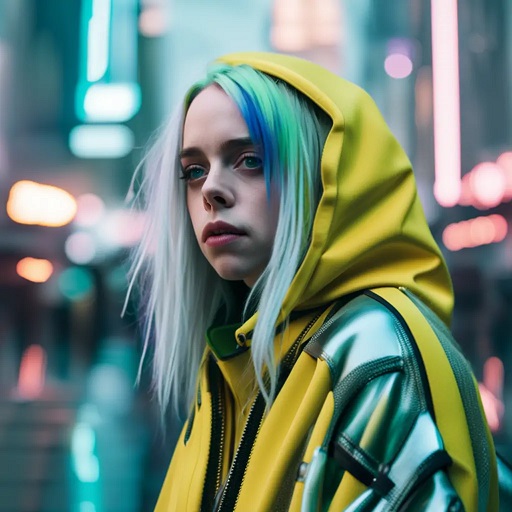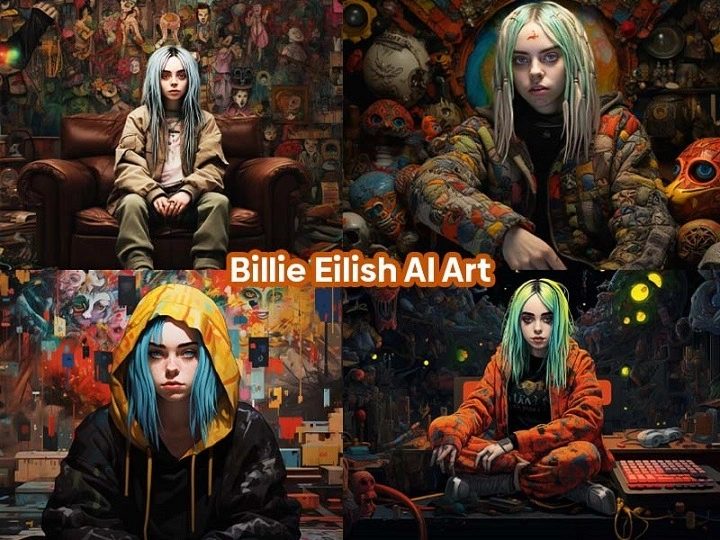In recent years, artificial intelligence (AI) has revolutionized numerous fields, including art. One particularly fascinating intersection is AI art inspired by popular culture figures, such as Billie Eilish. This article delves into the world of Billie Eilish AI art, exploring its origins, the technology behind it, its impact on the art community, and the ethical considerations involved. Through a comprehensive examination, we aim to shed light on how AI is transforming the artistic representation of one of the most iconic musicians of our time.
The Rise of AI Art

What is AI Art?
AI art refers to artwork created with the assistance of artificial intelligence. This can involve a variety of AI technologies, including machine learning algorithms, neural networks, and generative adversarial networks (GANs). These technologies enable computers to analyze and generate artistic images, often in ways that mimic or extend human creativity.
Historical Context
- Early Beginnings: AI’s involvement in art can be traced back to experiments in the 1950s and 1960s when early computer scientists like Harold Cohen started using algorithms to create art.
- Evolution Over Decades: Over the years, advancements in AI technology have significantly improved the complexity and quality of AI-generated art. The introduction of GANs in 2014 by Ian Goodfellow marked a major milestone, allowing for the creation of highly realistic and intricate images.
Key Technologies Behind AI Art
- Machine Learning: Algorithms that enable computers to learn from data and improve over time.
- Neural Networks: Computational models inspired by the human brain, capable of recognizing patterns and generating new content.
- GANs (Generative Adversarial Networks): A class of AI where two neural networks (the generator and the discriminator) work against each other to create realistic images.
Billie Eilish: A Cultural Icon
Brief Biography
- Early Life: Born on December 18, 2001, in Los Angeles, Billie Eilish grew up in a creative environment. Her parents, both musicians, influenced her early interest in music and art.
- Rise to Fame: Eilish gained international fame with her debut single “Ocean Eyes” in 2015. Her unique style and voice quickly captivated audiences worldwide.
- Accolades: Over the years, Billie Eilish has won multiple Grammy Awards and continues to be a significant influence in the music industry.
Impact on Popular Culture
- Fashion Icon: Known for her distinct style, Billie Eilish has set trends in fashion with her oversized clothing and vibrant hair colors.
- Advocate for Mental Health: Eilish often speaks about mental health issues, resonating with a younger audience and promoting awareness.
- Innovator in Music: Her innovative approach to music, blending genres and experimenting with sound, has set her apart as a trailblazer in the industry.
The Convergence of AI and Billie Eilish Art
How AI is Used to Create Art
- Data Collection: AI algorithms analyze thousands of images and videos of Billie Eilish to understand her features, expressions, and style.
- Training Models: These data are used to train neural networks, teaching them to generate new images that resemble Eilish.
- Art Generation: Once trained, these models can create unique pieces of art, ranging from realistic portraits to abstract representations.
Popular Platforms and Tools
- DeepArt: An online platform that uses neural networks to transform photos into artwork in various styles.
- Artbreeder: A tool that allows users to blend images using GANs, creating new and unique portraits.
- RunwayML: A platform that provides tools for artists to create AI-generated art without requiring extensive programming knowledge.
Examples of Billie Eilish AI Art
Realistic Portraits
- Hyper-Realistic Images: AI can generate images of Billie Eilish that are almost indistinguishable from real photographs.
- Artistic Variations: These portraits can be stylized to mimic the techniques of famous artists, such as Van Gogh or Picasso.
Abstract and Surreal Art
- Dreamlike Interpretations: AI art can create abstract representations of Billie Eilish, blending her features with surreal landscapes and patterns.
- Exploring Emotions: These pieces often evoke strong emotional responses, capturing the essence of Eilish’s music and persona.
Fan Contributions
- Social Media: Platforms like Instagram and Twitter are filled with AI-generated art created by fans, showcasing their interpretations of Billie Eilish.
- Collaborative Projects: Artists and AI enthusiasts often collaborate to create unique pieces, merging human creativity with machine precision.
The Artistic Community’s Response
Embracing AI Art
- New Mediums: Many artists view AI as a new medium that expands the boundaries of traditional art forms.
- Collaborative Potential: The collaboration between human artists and AI is seen as a way to push creative limits and explore new artistic possibilities.
Criticisms and Concerns
- Authenticity Issues: Some critics argue that AI-generated art lacks the authenticity and emotional depth of human-created works.
- Job Displacement: There are concerns about AI potentially displacing human artists, especially in commercial art fields.
Ethical Considerations

Copyright and Ownership
- Who Owns AI Art?: Determining ownership of AI-generated art is complex. Is it the creator of the AI, the person who trained it, or the AI itself?
- Copyright Laws: Current copyright laws are struggling to keep up with the rapid advancements in AI art, leading to legal ambiguities.
Representation and Bias
- Bias in Training Data: AI models can inherit biases present in their training data, leading to skewed or problematic representations.
- Cultural Sensitivity: It’s crucial to consider cultural and personal sensitivities when creating AI art, especially when dealing with public figures like Billie Eilish.
The Future of AI Art
Technological Advancements
- Improved Algorithms: As AI technology continues to evolve, the quality and creativity of AI-generated art will improve.
- Interactivity: Future AI art may become more interactive, allowing audiences to engage with and influence the art in real-time.
Integration into Mainstream Art
- Exhibitions and Galleries: AI art is increasingly being showcased in mainstream art galleries and exhibitions.
- Market Value: The market for AI-generated art is growing, with some pieces selling for significant sums at auction.
Educational Opportunities
- Learning Tools: AI art platforms are becoming valuable tools for teaching art and creativity in educational settings.
- Skill Development: Artists can use AI to develop new skills and techniques, blending traditional and digital art forms.
The intersection of Billie Eilish and AI art represents a fascinating convergence of technology, creativity, and popular culture. As AI continues to evolve, it will undoubtedly reshape the artistic landscape, offering new opportunities and challenges for artists and audiences alike. Whether embraced or critiqued, AI art is a testament to the endless possibilities of human ingenuity and technological innovation. By understanding and exploring this dynamic field, we can better appreciate the future of art and its ever-changing relationship with technology.


